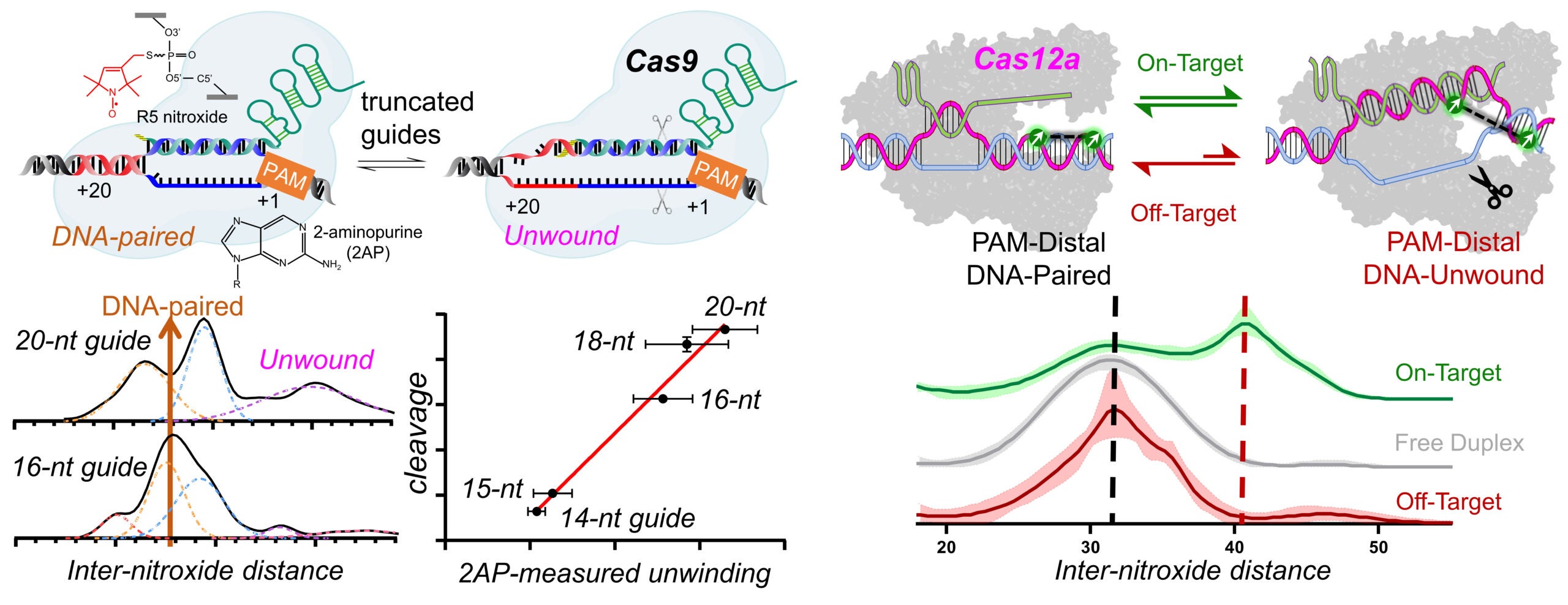Biophysical Investigations on Nucleic Acids Recognitions
Biology operates on controlling interactions between molecules, and knowledge on specificity of molecular interaction is the foundation for understanding native biological functions, intervening with abnormal disease-causing processes, and engineering novel capabilities and devices. We are interested in deciphering mechanisms employed for specific recognition of nucleic acids, in particular DNA that is central in transmission of genetic information. We utilize a unique site-directed spin labeling technique synergistically with a broad range of biophysical and biochemical methods to unravel the structure-dynamics-function relationship that dictates specific recognition of DNA by bio-molecular complexes (e.g., CRISPR) as well as small-molecule drug compounds. We apply the knowledge gained to inform genome engineering as well as diagnostic and therapeutic developments.
-

Site-Directed Spin Labeling (SDSL) monitors site-specifically attached stable radicals (e.g., nitroxide spin labels) using electron paramagnetic resonance (EPR) spectroscopy, and provides structural (e.g., distance constraints) and dynamic (e.g., motions at the labeling site) information on the parent molecule under physiological conditions. My laboratory has developed spin labeling methods for studying nucleic acids in bulk solutions and at the single-molecule level. SDSL methodologies we developed have provided unique information on sequence-dependent DNA shape and its contribution to specific protein/DNA recognition; interactions between DNA G-quadruplexes and metal-based small molecules; and global structure and dynamics of large non-coding RNAs. We are applying spin-labeling in conjunction with other tools to investigate mechanisms of DNA target recognition by the programmable CRISPR nucleases, and we continue to develop spin-labeling based methods for molecular characterization. (read more …)
-

CRISPR has ushered in a revolution in genome engineering and manipulation that is still rapidly evolving. Continuing advance of CRISPR-based technology relies on in-depth mechanistic understanding on the structure-dynamics-function relationship that governs CRISPR target selection. The Qin lab studies mechanisms of CRISPR-Cas9 and Cas12a, the two most widely used systems for genome manipulation. A combination of spin-labeling, fluorescence spectroscopy, and other biophysical methods are applied to probe structure and dynamics of Cas9 and Cas12a complexes, and the findings are correlated with functional outcomes obtained from detailed enzyme kinetics analysis, bioinformatics, and other biochemical approaches. Work has uncovered specificity checkpoints built upon equilibrium in DNA unwinding, and shed light on the similarity and difference between Cas9 and Cas12a. Studies are on-going on further delineating the connection between sequence-dependence DNA duplex features (DNA shape) and Cas9a/Cas12a target selection, and incorporating the finding in developing genenome editing applications with enhanced specificity. (read more …)
-

DNA Shape refers to physical properties of DNA duplex (i.e., flexibility, bendability, electrostatics) that are collectively determined by local core sequence, peripheral elements, and other factors (e.g. topology). It has been long recognized that DNA Shape dictates specific DNA recognition beyond the linear base sequence. However, we are yet able to deduce detailed DNA shape information from a given linear genome sequence. Work in the Qin lab has demonstrated that spin-labeling can provide sequence dependent DNA shape information in both the free duplex and in the protein-DNA complexes. These spin-labeling methods, in conjunction with other biophysical tools, are being applied to investigate DNA shape features of long, free duplexes under different topological constraints, and to elucidate impacts of DNA shape on Cas9 and Cas12a target interrogation. (read more …)